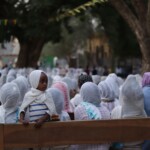By Feven Mekuria Feventassaw.Mekuria@care.org and Ryan Derni Ryan.Derni@care.org
To meet the unique needs of married adolescent girls in rural Ethiopia and address the gap in global programming for this population, CARE created the TESFA program in 2010. TESFA – ‘hope’ in Amharic – sought to mitigate the harmful effects of child marriage by creating opportunities for girls to engage in economic activities, learn sexual reproductive health knowledge, and improve their communication and negotiation skills through peer-based solidarity groups. Recognizing that girls’ lives cannot be transformed without challenging and changing restrictive societal norms, TESFA also directly engaged village elders, religious leaders, health workers, mothers-in-law, and girls’ husbands in reflective dialogue and action in support of adolescent girls’ access to information and services. The ‘Ex Post Evaluation’ of TESFA, carried out four years after the program ended, showed that the improved sexual and reproductive health and economic empowerment outcomes and process were not only sustained, all 196 of the girls and community groups surveyed continue to meet, and as much as 60% of the girl groups have self-replicated to include more girls. In 2018, CARE launched an investigative research process to inform the design of a new more scalable and impactful iteration of TESFA, called TESFA+. This comprised a systematic mapping of the status of TESFA groups across the intervention areas as well as of potential future implementers, and an in-depth qualitative evaluation of the conditions required for program scale-up, success and sustainability. TESFA+ is now in the process of being scaled up using insights from end-users and local government partners, through integration of the model into government structures, working with diverse platforms at national and regional levels, and leveraging exist- ing forums. Additionally, TEFSA+ is exploring ways to enhance the social capital for girls through inter-group connectivity and building solidarity that supports replication of the model and reach to more girls.



